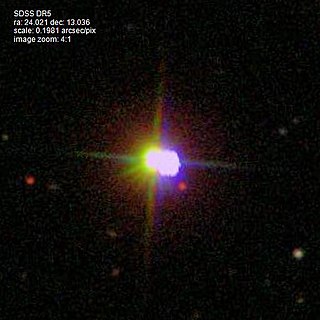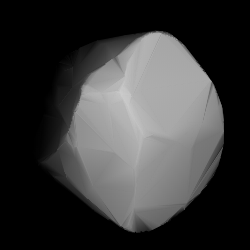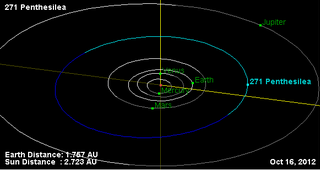Related Research Articles

47 Aglaja is a large, dark main belt asteroid. It was discovered by Robert Luther on 15 September 1857 from Düsseldorf. The name was chosen by the Philosophical Faculty of the University of Bonn and refers to Aglaea, one of the Charites in Greek mythology. It was rendered Aglaia in English sources into the early 20th century, as 'i' and 'j' are equivalent in Latin names and in the Latin rendering of Greek names.

Bertha is a main-belt asteroid. It was discovered by the French brothers Paul Henry and Prosper Henry on 4 November 1875, but the credit for the discovery was given to Prosper. It is probably named after Berthe Martin-Flammarion, sister of the astronomer Camille Flammarion.

Irma is a fairly large and dark main belt asteroid. It was discovered by the French brothers Paul Henry and Prosper Henry on November 5, 1877. Paul was credited for this discovery. The meaning of the name Irma is unknown.

225 Henrietta is a very large outer main-belt asteroid. It was discovered by Austrian astronomer Johann Palisa on April 19, 1882, in Vienna and named after Henrietta, wife of astronomer Pierre J. C. Janssen. The asteroid is orbiting at a distance of 3.39 AU from the Sun with a period of 6.24 years and an eccentricity (ovalness) of 0.26. The orbital plane is inclined at an angle of 20.9° to the plane of the ecliptic. 225 Henrietta belongs to Cybele group of asteroids and is probably in a 4:7 orbital resonance with the planet Jupiter.
Clementina is a large main belt asteroid that was discovered by French astronomer Henri Joseph Anastase Perrotin on 11 October 1885 in Nice, France. The origin of the name is not known.

Penthesilea is a mid-sized main belt asteroid that was discovered by Viktor Knorre on 13 October 1887 in Berlin. It was his last asteroid discovery. The asteroid was named after Penthesilea, the mythical Greek queen of the Amazons.
Messalina is a minor planet, specifically an asteroid orbiting primarily in the asteroid belt. It was discovered on 3 October 1904 by Paul Götz, at Heidelberg. It is named after Valeria Messalina, the third wife of Roman Emperor Claudius.
Bilkis is a minor planet, specifically an asteroid orbiting in the asteroid belt. It was discovered by German astronomer August Kopff in 1906 February and was given the Koran name for the Queen of Sheba. Photometric observations at the Palmer Divide Observatory in Colorado Springs, Colorado in 2006–7 were used to build a light curve for this object. The asteroid displayed a rotation period of 8.5742 ± 0.0005 hours and a brightness variation of 0.40 ± 0.02 in magnitude.

Polyxena is a minor planet orbiting the Sun. This main belt asteroid was discovered on 27 March 1906 by German astronomer August Kopff at the Heidelberg observatory. It was named after the youngest daughter of Priam and Hecuba, king and queen of Troy during the Trojan War. 595 Polyxena is orbiting at a distance of 3.21 AU from the Sun, with an orbital eccentricity (ovalness) of 0.06 and a period of 5.75 yr (2,099.1 d). The orbital plane is inclined at an angle of 17.8° to the ecliptic.

Juvisia is a minor planet, specifically an asteroid orbiting in the asteroid belt that was discovered 27 August 1906 in Heidelberg by German astronomer Max Wolf. It was named after the commune Juvisy-sur-Orge, France, where French astronomer Camille Flammarion had his observatory.
607 Jenny is a minor planet, specifically an asteroid orbiting in the asteroid belt that was discovered by German astronomer August Kopff on September 18, 1906.
610 Valeska is a minor planet, specifically an asteroid, orbiting primarily in the asteroid belt. Discovered in 1906 by Max Wolf. The origin of the name is unknown, but it may be related to the provisional designation 1906 VK. In Slavic origin, it also means Glorious ruler. Photometric observations provide a rotation period of 4.9047±0.0002 h with a brightness variation of 0.17±0.03 in magnitude.
618 Elfriede is a minor planet orbiting the Sun. On July 24, 2013, it occulted the magnitude 12.8 star 2UCAC 23949304, over parts of Mexico and southwestern United States.
620 Drakonia is a minor planet, specifically an asteroid orbiting in the asteroid belt. It was discovered October 26, 1906, in Taunton, Massachusetts, by American astronomer Joel Hastings Metcalf and given the preliminary designation 1906 WE. It may have been named for Drake University.
627 Charis is an asteroid and the parent body of the Charis family, located in the outer regions of the asteroid belt, approximately 49 kilometers in diameter. It was discovered on 4 March 1907, by German astronomer August Kopff at the Heidelberg-Königstuhl State Observatory in southwest Germany. The asteroid was named after the Greek goddess Charis, a name which may have been inspired by the asteroid's provisional designation 1907 XS.
724 Hapag is a minor planet orbiting the Sun in the asteroid belt that was found by Austrian astronomer Johann Palisa in 1911 and named after the German shipping company Hamburg America Line. It was assigned a provisional name of 1911 NC, then became a lost asteroid until it was rediscovered in 1988 as 1988 VG2 by Tsutomu Hioki and N. Kawasato at Okutama, Japan.
756 Lilliana is a minor planet orbiting the Sun that was discovered by American astronomer Joel Hastings Metcalf on 26 April 1908 from Taunton, Massachusetts. It rotates around its axis of rotation every 9.36 hours.
765 Mattiaca is a minor planet, specifically an asteroid orbiting in the asteroid belt. Photometric observations made in 2011–2012 at the Organ Mesa Observatory in Las Cruces, New Mexico produced an irregular light curve and a period of 3.4640 ± 0.0001 hours with a brightness variation of 0.09 ± 0.01 in magnitude. Mattiacum was the Latin name for the city of Wiesbaden, Germany, birthplace of the discoverer.
860 Ursina is a minor planet orbiting the Sun that was discovered in 1917 by German astronomer Max Wolf. The origin of the name is unknown.
880 Herba is a minor planet orbiting the Sun that was discovered by German astronomer Max Wolf on 22 July 1917 in Heidelberg.
References
- ↑ Noah Webster (1884) A Practical Dictionary of the English Language
- 1 2 Yeomans, Donald K., "164 Eva", JPL Small-Body Database Browser, NASA Jet Propulsion Laboratory , retrieved 5 May 2016.
- 1 2 Pilcher, Frederick (October 2012), "Rotation Period Determinations for 47 Aglaja, 252 Clementina, 611 Valeria, 627 Charis, and 756 Lilliana", Minor Planet Bulletin, vol. 39, pp. 220–222, Bibcode:2012MPBu...39..220P.
- ↑ "Numbered Minor Planets 1–5000", Discovery Circumstances, IAU Minor Planet center, retrieved 7 April 2013.
- ↑ Schmadel, Lutz D. (2012), Dictionary of Minor Planet Names (6th ed.), Springer, p. 60, ISBN 3642297188.